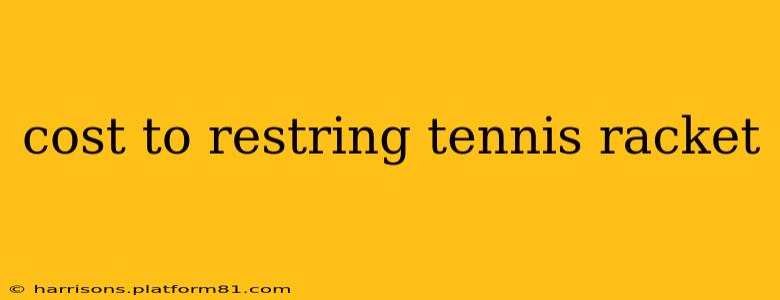Restringing your tennis racket is crucial for maintaining optimal performance and preventing injuries. However, the cost can vary significantly depending on several factors. This guide will break down the price, influencing variables, and help you make informed decisions about your racket's care.
What Factors Influence the Cost of Restringing a Tennis Racket?
Several key elements contribute to the final price you'll pay to restring your tennis racket:
-
String Type: This is arguably the biggest factor. Natural gut strings are the most expensive, offering exceptional feel, power, and comfort but requiring more frequent restringing. Synthetic strings, such as polyester, nylon, or co-polyester, offer a wider range of price points and performance characteristics. Polyester strings are generally durable and offer good control, while nylon is softer and more comfortable. Co-polyester strings often blend the properties of both.
-
String Gauge: Thicker strings (lower gauge number, e.g., 16 gauge) are generally more durable but can feel less comfortable and offer less power. Thinner strings (higher gauge number, e.g., 18 gauge) are more comfortable and offer more power but break more easily. The choice influences both the cost of the strings and the labor involved in restringing.
-
Tension: The tension at which the strings are strung significantly impacts playability and string longevity. Higher tension provides more control but can lead to faster string breakage. Lower tension offers more power and comfort but may result in a less crisp feel. While the tension itself doesn't directly impact the cost, the time required for a professional stringer to achieve a precise tension may influence labor charges, especially for intricate patterns or unique tension requests.
-
String Pattern: The pattern of strings on your racket's frame can influence the overall cost. More complex patterns might require more time and expertise, potentially increasing the labor charge.
-
Location: Restringing costs can vary geographically. Shops in affluent areas or those with higher operating costs may charge more than those in less expensive locations.
How Much Does it Typically Cost to Restring a Tennis Racket?
Generally, you can expect to pay anywhere from $25 to $75 or more for a basic restringing job. This price usually includes the cost of synthetic strings. If you opt for natural gut, expect to pay significantly more, potentially adding $50 or more to the total cost.
What is included in the price?
The cost typically covers:
- Labor: The time and expertise of the stringer. This is a significant portion of the overall cost.
- String Material: The cost of the strings themselves, which varies widely depending on the type and gauge.
How Often Should I Restring My Tennis Racket?
The frequency of restringing depends on several factors, including the type of strings used, the frequency of play, and the tension at which the strings are strung. As a general rule of thumb, most players should restring their rackets every 2-6 months, or every 10-20 hours of play. Inspect your strings regularly for signs of breakage, fraying, or loss of tension.
Can I Restring My Racket Myself?
While you can purchase restringing tools and attempt to do it yourself, it's generally recommended to have a professional restring your racket. Improper restringing can damage your racket and potentially lead to injury. The tools alone can cost a significant amount, and developing the skill and precision requires substantial practice and experience.
What are the different types of tennis strings?
As mentioned earlier, the main types of tennis strings are natural gut, polyester, nylon, and co-polyester. Each type offers different characteristics in terms of feel, power, control, and durability, which all affect the cost. A professional stringer can help you choose the best strings for your playing style and level.
Does the type of racket affect restringing costs?
While the type of racket itself doesn't directly affect the cost of restringing, the string pattern and recommended string tension might influence the labor involved. Some rackets have more complex string patterns, which may slightly increase the restringing time and therefore cost.
By understanding these factors, you can better prepare for the cost of keeping your tennis racket in top condition. Remember, regular restringing is an investment in your game and can prevent injuries.
